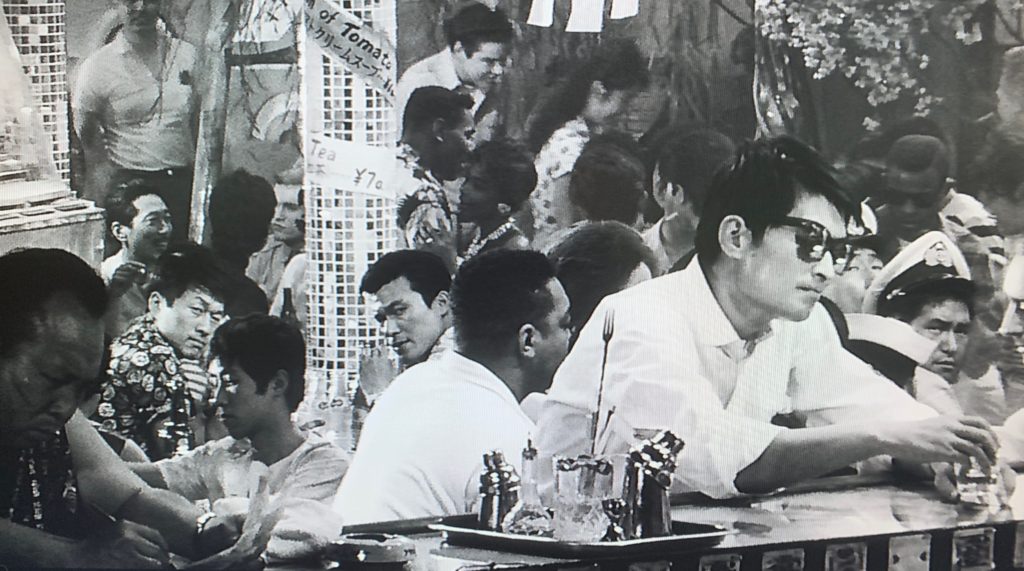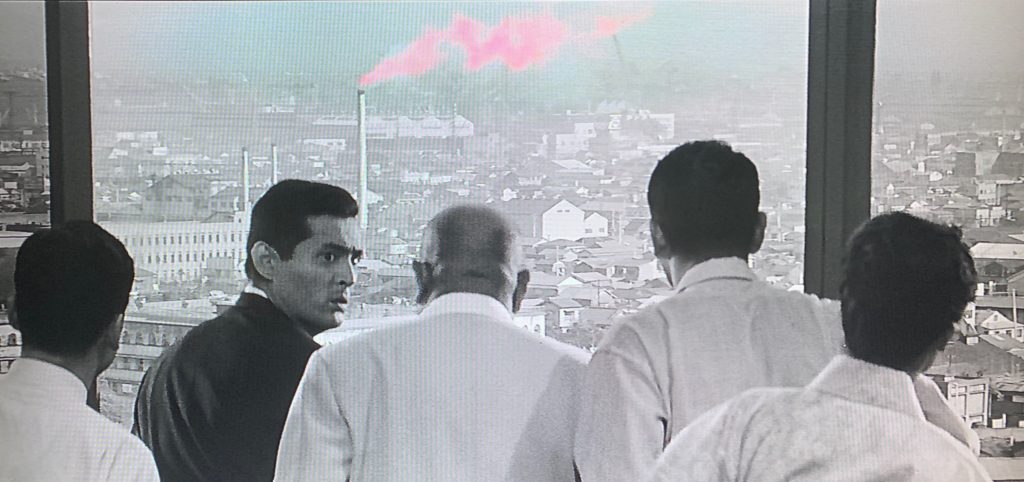-
Fast & Furious Presents: Hobbs & Shaw (2019): A motion picture I can only describe, and I apologize for this, as “nut-slammingly stupid.” It’s the Michael Scarn ripoff of itself. It’s as fascistic as a third-grader’s hypermasculine playground fantasy, lacking even the level of self-reflection I can credit to Predator (1989), and nudely calculated for maximum financial return; the frame might as well be stamped at the bottom with A SIGNIFICANT PROFIT SHARE BROUGHT TO YOU BY DWAYNE JOHNSON’S SEVEN BUCKS PRODUCTIONS®. Plus there’s an early set piece where the characters triumphantly pull off the exact same stunt that kills Johnson’s character in The Other Guys (2010).
I cannot justify why I paid first-run ticket price to see this movie, except that of course I did, it has “Fast” and/or “Furious” in the title. It does not live up to the best of its parents, but there are moments in the third act when Johnson’s proclivities almost transcend their setting. I can get behind inserting tough matriarchs and a badass Siva Tau into every movie you make! But nothing else here rises above the cash-extracting function of a boot stamping on a human testicle forever.
-
Gimme the Loot (2012): I cannot remember to take last night’s leftovers out of the fridge for lunch most days, but I skimmed a review of this mildly buzzy indie film before Barack Obama was reelected and my brain has been bothering me about seeing it ever since. So I biked around the corner and rented it! Thanks, Movie Madness.
Recommended, if not revelatory, especially if you like stories about graffiti dorks. Tashiana Washington (as Sophia) is a standout, and I appreciated that the director relied on her charisma without sexualizing her. This is the kind of movie where the characters’ schemes are well awry before they are even conceived, much less executed, and I sometimes have a hard time with that! I enjoy a bale of haywire, and it’s one thing if I don’t feel sympathy for the schemers—eg my delight in anticipating disaster on Arrested Development—but when I can guess how things are going to go and have to wait and wait for the characters to get there and feel bad, I end up wanting to crawl out of my skin. It’s like Leonard’s zap zap zap on the scale of ten minutes instead of two. Anyway this movie toes that line a little but pulls it out.
-
High and Low (1963): This was a pretty nuts-and-boltsy, unshowy police procedural with all its emotional fireworks loaded front and back. I continue to enjoy the sheer execution of Kurosawa’s movies and I will once again show you a photograph I took of my television to illustrate why.

There are like fifty people in this shot. When I look at it, my eyes jump to four or five of them: the man in sunglasses in the foreground, plus the two men on the left and the two men in captains’ hats on the right watching him (the suspect and the cops following him, respectively). One of the boat hat dudes has his face partially covered and one might not parse him at first, but the gist of “here’s our guy and here’s his tail” comes across immediately. The effect is even more pronounced when it’s moving instead of still.
Some of this is angle work and blocking, because the eye tends to look at people with their full faces turned toward you. Some of it is lighting—most of the other people have shadowed faces, and theirs are subtly spotlit. That must have been fucking complicated, but I can at least imagine how you’d do it.
What took me days to figure out is the focus. All of those guys are nice and crisp, in their various positions, so the depth of field isn’t super tight. There are some people way in the back who are blurry, and that makes sense too. But then there are people like the dancer in sunglasses just above the boat hats. He’s blurry, and he’s closer to the lens than the cop in the Hawaiian shirt. That does not make physical sense! Lenses do not work that way! In 2019 this would be trivial to throw at a computer, but there was no cheating in 1963.
I finally determined that they didn’t do selective lens-smearing or tilt-shift or rear projection or anything like that—they just hung a super thin scrim between those mirrored columns, pulling out an old theater trick to subtly dial down the contrast and focus and brightness in the back. That must have made the lighting even more complicated, because you have to light a scrim from an angle to get that gauzy effect, but they did it and it worked! All because Kurosawa (and his cinematographers, Asakazu Nakai and Takao Saitô) cared about making this shot read fast and well.

- The Invincible Armour (1977): This is a classic martial arts movie that uses shots of an egg exploding in a closed fist to illustrate the destruction of a man’s scrotum. Kind of dismayed at the theme emerging this month.
- Mr. and Mrs. Smith (2005): This is a funny one. I never watched it because I bore it a grudge when it came out; I was still mad about the cancellation of a 90s Scott Bakula-Maria Bello tv show of the same name and similar concept, which my family fervently loved (and which does not hold up to a rewatch). The movie turns out to be quite stylish and slickly executed—once again, exactly what I should learn to expect from Doug Liman—but it’s supposed to have two protagonists and instead has zero. I think it’s trying to react to the idea promulgated in many, many movies that upper-middle-class suburban life is a decaying illusion by asserting that, no, Crate & Barrel heterosexuality is cool and rad, sunglasses emoji? I did not find its argument compelling.
- The Talented Mr. Ripley (1999): Whereas this movie about sociopathic romance I found very compelling indeed. I rented it for the costuming (because, sigh, I have been reading too many blogs about menswear) and was surprised at how erotic I found it, including but not limited to the part where Jude Law gets his dick out. The cast is full of ringers, the costuming is indeed incredible, and I loved how the lighting moves from deliciously sun-drenched to deliciously lurid. I haven’t read the original Patricia Highsmith book, but now I want to; if it’s also about the murderous violence of the closet and the way it twists people into mimesis by robbing them of themselves, then the movie delivers that really well.
- Snake in the Eagle’s Shadow (1978): This is a classic martial arts movie—the first starring Jackie Chan!—in which… welp. Baby Jackie is great, of course, and the movie was directed by Yuen Woo-Ping, which means the choreography is excellent but actual shots and editing are all cribbed pretty indifferently from the 70s Hong Kong stylebook. The real delight is Yuen’s actual dad playing the spry old teacher, who steals every scene without repentance.
- Goodbye South, Goodbye (1996): God dammit, I love Hou Hsiao-Hsien. I have only a vague idea of what happened in this movie, though the subtitling was fine. It is not a spoiler to say that the final shot, which goes on for at least a minute, is literally “a distant car gets stuck in a ditch (maybe??).” But Hou has such a gift for keeping my eyes interested and engaged even when nothing apparent is happening! Hell yes long slow wide shots of inscrutable people who aren’t even in frame half the time!! Fuck me up!!!!
- Maidentrip (2013): Lucy requested to watch this documentary about a teenage girl sailing around the world alone (albeit, one gradually figures out, sometimes with a week or a month of time off between stops) and it’s warm and cheering. Spoiler: she succeeds and does not die, but don’t google what happened to her boat later if you want to stay cheered. I enjoyed the movie, and learning about some funny sailing rituals that appear in it; I think the most extraordinary thing about it is that it was primarily self-filmed. There’s plenty of insert and pickup footage, but mostly this is a movie a teenage girl shot herself, about herself, without apology. In the background is the other thing that struck me, which is that her parents accepted and enabled their kid going out of their lives for a year. She’s a visibly different person by the end! It’s hard for me to imagine having that kind of independence as a young person, but even harder to think of yielding to it at such a formative time in one’s daughter’s life.
-
Minding the Gap (2018): I wasn’t intending to watch two self-shot documentaries about young people in a row, but I stumbled onto this (on Hulu!) and got drawn in. It’s an extraordinary movie, one of those I feel most motivated to recommend in my entire 2019 list.
It was really affecting to me to figure out the nature of the film as I watched it, but I don’t want to recommend it without a content warning: this is a movie about abusive fathers, and the people their sons become. That makes it sound like it’s hard to watch, but while certainly some of it is difficult to sit with, it’s never cruel to the audience. Most of the film is charming, goofy, and evocative, with gorgeous bursts of wordless beauty and arresting glimpses into consequence, or into the challenges its creator faced. And the musical conclusion pierced me right through.
The other thing is that this is a skateboard movie. I never had a skateboard when I was young, though I adopted some distinctly skateresque clothing choices. I didn’t have the opportunity to learn to skate, really, but even if I had I know I wouldn’t have had the patience or the grace. I admire it very much as a skill. It’s not as if skate videos are a new phenomenon, but Bing Liu is a good enough at those alone to grab your attention. I was impressed by Point Break (1991) getting its surf shots through a crew of seasoned professionals who got paid presumably well to risk their necks. The skating sequences in this movie were shot by one kid. One kid.
-
Destroy All Monsters (1968): Despite its awesome title, clear potential, stellar production crew and mighty budget, I’m afraid, my friends, that this movie is not very good. The traditional way to make a kaiju movie bad is to skimp on the expensive monster effects sequences by putting in lots of plotty stuff focusing on concerned humans no one cares about. This movie clearly spent gobs of money on effects shots, but almost none of them include the frickin monsters! There are ten minutes of slow, majestic rocket landings for every minute of monster screen time, which means this movie shorts both them and the audience. This is a movie featuring Mothra where Mothra NEVER TURNS INTO A MOTH.
There are great moments, including a shot of the Arc de Triomphe being demolished while a reporter declares “ze Arc has fallen… and soon, Paree!!” and also Godzilla contemptuously slapping down Ghidorah’s head like a deflated basketball. And if there are too many shots of miniature vehicles, at least the minis work is advanced and great! But while I only know a tiny bit about the movie’s production history, it’s very clear it came from people who were just done with giant monsters after fourteen years. I just realized as I typed this that it’s an Avengers movie. Of course it was doomed.
In conclusion, at no point in this motion picture does anyone shout “destroy all monsters!” or indeed make any attempt to destroy all monsters, and on that, your honor, the offense rests.